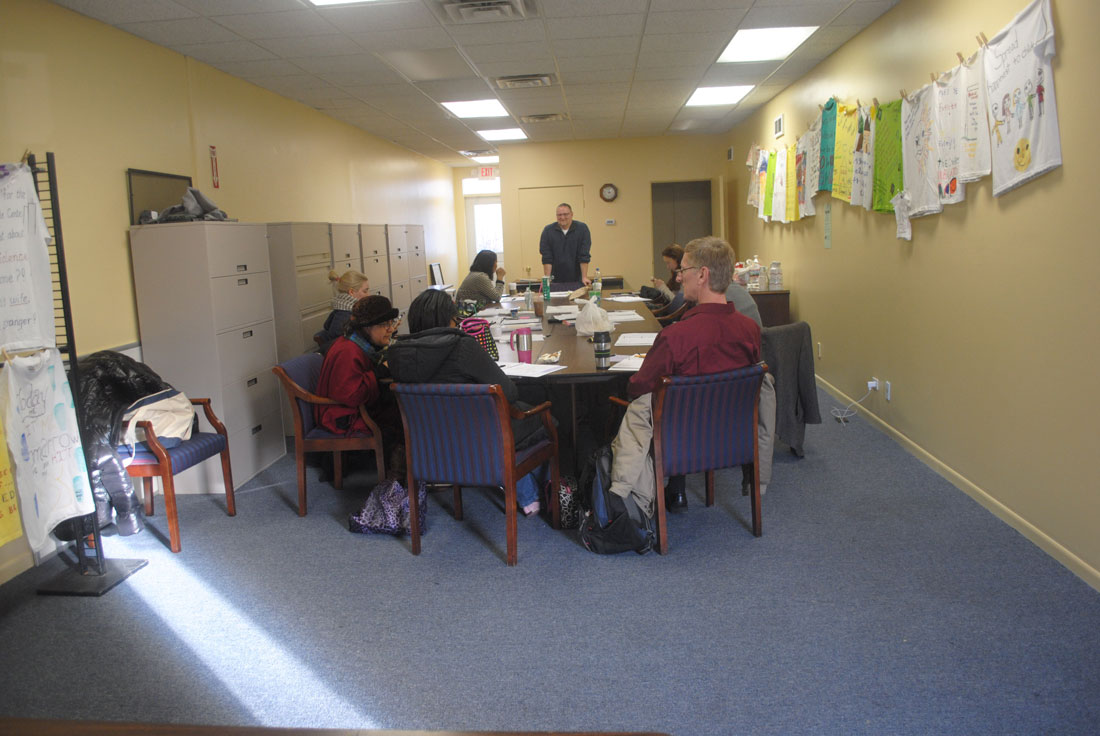By Elyse Samuels
Ten adults sit around a long rectangular table in a comfortable conference room with t-shirts adorning the walls proclaiming statement such as, “hands are for helping, healing, holding, not for hitting” or “everyone deserves a happy home, everyone deserves to smile.”
For 20 hours over the course of three days this group and these statements of domestic violence filled the South Suburban Family Shelter as part of the abuser intervention facilitator training.
“We’re trying to stop domestic violence, keep victims and children safe,” said Brianne Hetman, director of community programs at SSFS “and keep each offender accountable.”
This 20-hour intervention program, known also as the Partner Abuse Intervention Program (PAIP), started in 2008 when SSFS created it’s own training manual, which is approved by the Illinois Department of Human Services and the Illinois Certified Domestic Violence Professional Board. Any professional working with domestic violence perpetrators is required to attend one of these training sessions.
After completion, participants are approved to work with referrals from the courts, Department of Children and Family Services and other agencies.
Morgan Kelly, with sparkled gold nails and an intricate tattoo on her right arm, smiles brightly, as she explains she is majoring in art therapy at Columbia College. She said art therapy uses different artistic methods to help patients overcome adversity in their lives. Kelly must choose a concentration within art therapy. She said she is considering domestic violence.
“The training is very informative,” Kelly said. “I didn’t know a lot about domestic violence. This goes into how people act, not just survivors but also perpetrators.”

That’s the benefit of PAIP. Facilitators must completely understand how perpetrators think and learn that their previous experiences and environment might have led to their resorting to violence.
At first glance, participant Rosario Quick is small and even slightly reserved behind wiry glasses and a leopard-patterned hat. However, after talking for only a few minutes, she overwhelms the room with her conviction in ideas and effervescent.
“I really love the program,” Quick said. “With this training I think I’m going to stay working with perpetrators. I want to see both sides. I love this work because of the way that I feel when I help perpetrates recognize they’re not the bad people we think they are. They are normal people who made a bad choice.”
Although this is an admirable goal, it is also challenging. These trained professionals can’t accomplish rehabilitation without the cooperation of the perpetrators themselves.
“It’s participant dependent,” Hetman said. “Someone has to engage to see results. But I know that can be done.”
Hetman has been working at SSFS for 15 years and says perpetrators of domestic violence are an underserved population. To break the cycle of domestic violence, Hetman said she thinks more resources must be spent working to change the behavior of domestic violence perpetrators.
Cognitive behavioral therapy is an integral component of PAIP. According to Hetman, the difference from other types of therapy is that in this case, people’s lives are at risk. She said this is what motivates her every day.
“PAIP isn’t going to solve all the issues that makes up the environment perpetrators live in,” Hetman said. “It works but somebody has to do a lot of life changing work in order to get to that point.”
Quick agreed that abuse intervention facilitation is complex. She said she hopes the program can at the very least help perpetrators learn from their mistakes and change their behavior in the future.
“Sometimes perpetrators don’t see the whole picture, so we help them to see the different angles and corners of it,” Quick concluded.

